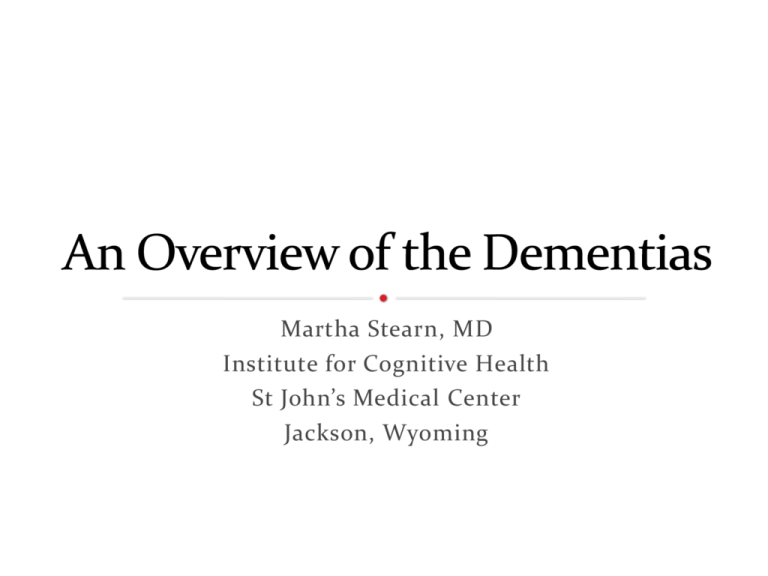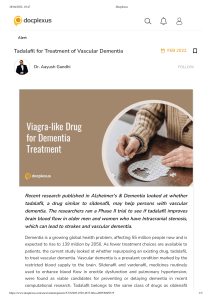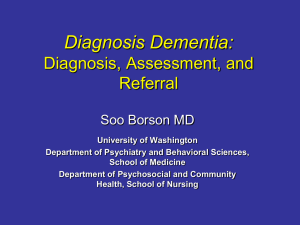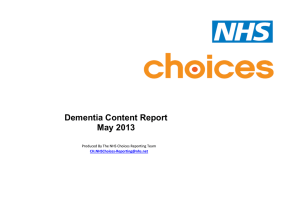Brain and Memory Basics
advertisement

Martha Stearn, MD Institute for Cognitive Health St John’s Medical Center Jackson, Wyoming 2% of the total body weight Uses 20% of the body’s blood supply Achieves it’s maximum weight at age 20 Most of brain’s oxygen use goes to grey matter Infancy communication Childhood language and spatial Young Adult brain growth peaks Middle Age memory, learning, more difficult Old Age continued slowing, more memories and wisdom The Cerebrum Brain Stem Cerebellum 100 billion cells One trillion connections SEROTONIN low levels in depression DOPAMINE low levels in DLB ACETYLCHOLINE low levels in AD, TBI, DLB, Vascular dementia NOREPINEPHRINE GLUTAMATE high levels in AD Loss of intellectual abilities of sufficient severity to interfere with occupational or social functioning to the point that one cannot function independently successfully The Memory Continuum PRECLINICAL the stage is being set CLINICAL Mild Cognitive Impairment DEMENTIA Conversion to dementia All involve abnormal deposition of specific proteins in the brain (amyloid and tau) that is a progressive process gradually damaging more neurons over time Clinical significance These proteins can be biomarkers for identifying those at risk Certain lifestyle changes have been shown to reduce that rate of protein deposition Research geared toward drugs that will eliminate, prevent or dissolve these proteins The Dementias Alzheimer’s Disease Vascular Dementia Dementia with Lewy Bodies FrontoTemporal Dementia Dementia of Parkinson’s Disease NPH 85 disease by age AMNESIA) Short term memory loss ( and at least one of the following domain dysfunctions: APHASIA AGNOSIA ABSTRACTION APRAXIA Also known as multi-infarct dementia Often presents as a mix with AD Risk factors similar to those for heart disease: Hyperlipidemia HTN Smoking Diabetes Family history for vascular disease Onset may appear more rapidly than AD May not be progressive if risk factors controlled VISUAL-SPATIAL PROBLEMS OFTEN MORE PROMINENT FROM THE START HALLUCINATIONS COMMON MENTAL STATUS TENDS TO FLUCTUATE UNPREDICTABLY DIFFICULTY WITH CIRCADIAN RHYTHM PARKINSONISM ON PHYSICAL EXAM More common than AD in the 50-65 age group Memory loss less likely to be presenting symptom Behavioral issues, change in personality, disinhibition are presenting hallmarks Language difficulties Cholinesterase inhibitors Donepezil Rivastigmine Galantamine Glutamate inhibitor Memantine Atypical antipsychotics Quetiapine Mirtazapine Risperidone Haloperidol—can be deadly for pts with dlb • Bad drugs: • antihistamines, haloperidol, hypnotics, benzodiazepines; narcotics • Anticholinergics: • bladder control meds; diarrhea control meds; some asthma drugs, eg tiotropium, ipratropium Behavioral issues Insomnia Depression Not eating Anxiety Hallucinations Paranoia Falling Driving Wandering Malnutrition Aspiration Making a diagnosis Medications Lifestyle Team approach Dealing with caregiver burden Neuropsychological testing Physical therapy for balance and fall prevention Speech therapy Occupational therapy for home safety evaluation and driving evaluation Support groups Exercise classes Brain Imaging Blood work: TSH, B12, Lipids, complete metabolic profile, CBC











